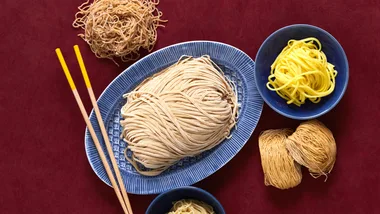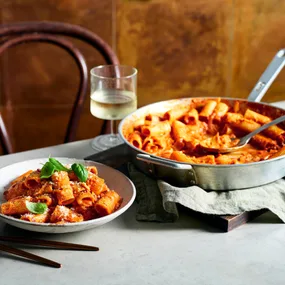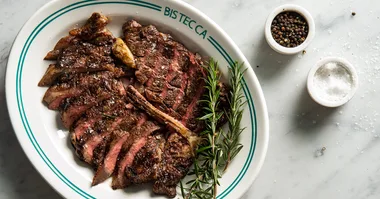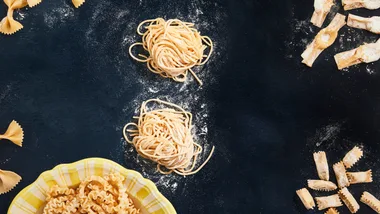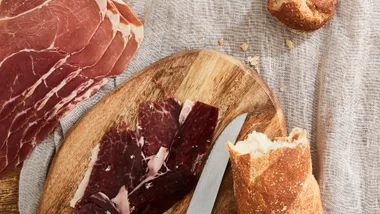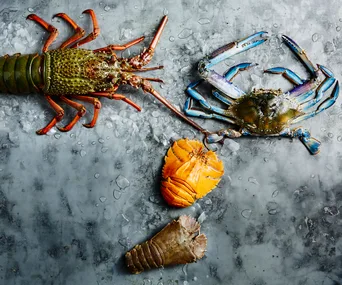Easter is of course the time for hot cross buns, but there are other yeasted baked goods studded with fruit that are traditional at this time. A fine example is kulich (pronounced koo-litch), an Orthodox Christian Easter bread hailing from Russia. My partner’s mother grew up in Turkey and her Russian mother used to make this version, a fairly classic recipe.

Step 1: Soak the dried fruit
Step 1: Soak the dried fruit
First, soak the dried fruit – a mixture of any dried fruit you like. I include mixed peel for a nice zesty note. The fruit is soaked in rum, which I warm first so it’s absorbed more easily. If you’re organised, soak the fruit overnight; otherwise a few hours will be fine.

Step 2: Infuse the milk with saffron
Step 2: Infuse the milk with saffron
Some kulich recipes include saffron, which adds a nice colour and a little extra flavour, but this comes down to personal preference. I use saffron powder rather than threads because it dissolves more evenly in the dough.
I don’t think you have to activate dried yeast in liquid first, but it helps set off the activity straight away. To do this, warm the milk to blood temperature and then add the yeast. Bubbles appear as it starts to activate; a little sugar helps the process along, too. I use milk as the liquid here which, along with the butter and eggs, makes a lovely rich dough.

Step 3: Cream the butter and sugar
Step 3: Cream the butter and sugar
While the yeast is activating, cream the butter and sugar in an electric mixer, using either a paddle or whisk attachment for this step. Beating the butter and sugar until the mixture is creamy and pale adds lightness to the cake, and softens the butter so it combines more effectively with the eggs. Some recipes say to add the eggs one at a time, but I like to whisk the eggs and yolks together first to break up the protein a little, which again combines more effectively. When you’re whisking in the beaten egg, the mixture will split a little, but the flour brings it back together.
Once the yeast mixture is added, switch to the dough hook. When all the ingredients are added be sure to knead the dough on slow speed to develop the gluten and give the dough elasticity (it also prevents the mixer overheating).

Step 5: Add the dried fruit, and leave the dough to prove
Step 5: Add the dried fruit, and leave the dough to prove
Once the dough is ready, stir in the nuts and fruit and then transfer the dough to a lightly greased bowl, cover it and set it aside in a draught-free place until it has doubled in size, which takes about two hours. The slower the proving the better the flavour, so if it’s a cold day it may take longer, but you’ll have a better flavour. Knock back the dough, shape it to prove again. Proving the dough twice helps to develop the structure of the dough, and again the flavour.

Step 6: Knock back the dough, then place it in a mould
The dough is traditionally baked in tall cylindrical tins such as coffee tins, but here we’ve used a paper panettone mould, which you can find at good kitchenware shops.
.

Step 7: Bake the kulich
Step 7: Bake the kulich
Once the kulich has increased its size to reach the top of the mould, bake it in your pre-heated oven.

Step 8: Make the icing
Step 8: Make the icing
A simple icing can be made using pure icing sugar. You’ll need to sieve all the lumps out, then add enough liquid just to form the drizzle consistency – one that will run down the sides a little, but still set, or you can brush it heavily over the top so it just reaches the sides. I like to use both lemon juice and cream to make a richer topping, but you can use other flavours, such as orange or rum.

Step 10: Serve your kulich with paskha
I’ve included here my recipe for paskha, a fresh farmhouse cheese that’s the traditional accompaniment to kulich in Russia. Western recipes tend to call for ricotta and cream cheese; I use ricotta and crème fraîche as the base and make a custard with cream. It’s not overly sweet – there’s not much sugar in the recipe but candied fruit adds a little more sweetness. Traditionally the paskha is set in flower pots lined with muslin to soak up the excess moisture that seeps out, or a wooden box, then weighted and refrigerated overnight. Often the top is marked with “XB”, meaning Christ is risen, shaped and decorated with more candied fruit.
Here we’ve served the paskha in a bowl and garnished it with extra candied peel. Spread it over your slices of kulich and you’ve got a lovely rich yeast-flavoured cake, with rich bursts of sweetness and texture from the cheese. Perfect with a hot cup of tea, or glass of Champagne


